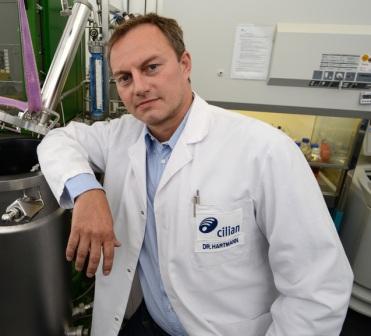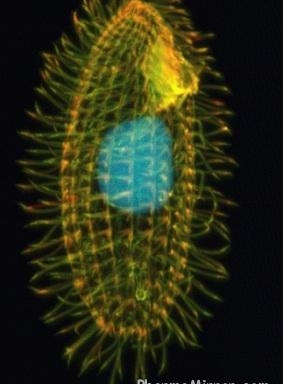Münster, Germany: In collaboration with the University of Edinburgh in Scotland the biotechnology firm CILIAN AG succeeded to reconstruct an important surface protein of the Malaria parasite.
The uniqueness of this vaccine is that it is produced in ciliates and covers nearly all variations of a certain parasite antigen – a worldwide novelty. This project was supported through a grant from the European Union of over one million Euros. Details of the development were published by the peer-reviewed journal “PLOS ONE” in form of a scientific paper.
Malaria is older than mankind itself: it wiped out entire nations and is suspected of having accelerated Rome’s downfall. Pharaoh Tutankhamen and Alexander the Great are among the most prominent suspected victims of the disease. Even though mankind has mounted heroic defense against Malaria for ages, over a million people still die of the disease each year, mostly children. Sadly every 30 seconds a child dies of Malaria.
The Guerilla War inside the human body
A development from Münster, Germany and Edinburgh, Scotland has now added a decisive weapon in the fight against this “marsh fever”. For the first time it was possible to combine a multitude of variations of a Plasmodium protein and develop a vaccine on this basis. The European Union supported this project with about 1 ½ million Euros.
The Malaria parasite wages something like a Guerilla war inside the body. The parasite is crafty in hiding and adapting to external circumstances. “CILIAN and we are one step ahead of the parasite” Dr. David R. Cavanagh of the Institute of Immunology and Infection Research at Edinburgh University explains the test results.
[wp_ad_camp_1]
Tests in animals showed a marked immune reaction. Details were published by the researchers in a scientific paper.
Edinburgh provides the building block for a “Super Protein”
Malaria infections usually begin with the sting of an Anopheles mosquito. The parasite gets into the body and multiplies in the liver. Once the parasite reaches its second development stage, the so-called merozoite stage, it begins to attack red blood cells, multiplies therein and destroys them.
In this process, bouts of fever occur. Since the red blood cells cannot supply the body with sufficient oxygen any more, hallucinations, heart palpitations and coma will occur. Children and pregnant women usually do not survive these conditions.
An effective vaccine acquaints the human immune system with the parasite before an infection takes place. This can be accomplished for instance through injection of surface proteins of the parasite. Through vaccination with proteins, the human body develops antigens that can detect the parasite and fight it.
The Malaria parasite is very flexible and mutates quickly, posing a major challenge for detection and treatment. For this reason, the University of Edinburgh compiled all variations of a surface protein in the merozoite stage, built them into a polymorphic multi domain malaria vaccine antigen and sent them to CILIAN in Münster.
A close relative is helper
CILIAN now was tasked to produce the protein. The key element in this effort are protozoans of the genus Tetrahymena that can be found in lakes or puddles.
Through genetic procedures, the research team at CILIAN makes Tetrahymena to produce the surface protein. Subsequently, it gets harvested and purified. This process is accomplished without any risk. Researchers do not even have to wear safety equipment during the process.
“It is advantageous that Tetrahymena is a close relative of the Malaria parasite. They are very similar in their morphology and physiology. This clearly represents an advantage compared to other approaches”, explains Dr. Markus Hartmann, CILIAN’s CSO.
In fact, many other attempts to develop compounds against Malaria did not produce the desired results. Oftentimes medicines were very effective in just a small number of patients and the parasite quickly developed resistance. “Malaria will not be able to do this with our vaccine. The parasite is being attacked more aggressively”, says Hartmann.
Vaccine production for image purposes
Statistically speaking, every second person is in danger of being infected with Malaria. The disease is assumed to be the driving factor behind the poverty in Southern countries. Regardless of the extent of poverty: The production of a Malaria vaccine is difficult to justify from a financial perspective. Main reason for this is that Malaria is more prevalent in financially poorer countries. Major corporations such a Glaxo Smith Kline deal with this subject for image and prestige reasons.
“It is very sad, if in the end millions of people need to die just because saving their lives proves to be financially unfeasible. We have not only found a very effective approach but one that is less complex in production and therefore less expensive”, explains Christian Scheiner, CILIAN’s CEO. He believes that Europe should be prepared to tackle Malaria. “In the context of increased globalization it is very hard to determine if Malaria may not – after all – become a problem for us also. The CDC already warns, that Anopheles that can transmit malaria are found not only in malaria-endemic areas, but also in areas where malaria has been eliminated. The latter areas are thus constantly at risk of reintroduction of the disease.”







